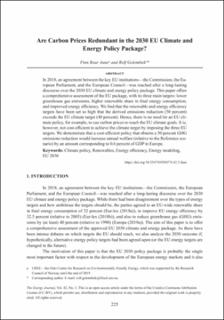| dc.contributor.author | Aune, Finn Roar | |
| dc.contributor.author | Golombek, Rolf | |
| dc.date.accessioned | 2022-03-21T15:58:45Z | |
| dc.date.available | 2022-03-21T15:58:45Z | |
| dc.date.created | 2021-06-09T16:42:28Z | |
| dc.date.issued | 2021 | |
| dc.identifier.citation | Energy Journal. 2021, 42 (3), 225-264. | en_US |
| dc.identifier.issn | 0195-6574 | |
| dc.identifier.uri | https://hdl.handle.net/11250/2986625 | |
| dc.description.abstract | In 2018, an agreement between the key EU institutions—the Commission, the European Parliament, and the European Council—was reached after a long-lasting discourse over the 2030 EU climate and energy policy package. This paper offers a comprehensive assessment of the EU package, with its three main targets: lower greenhouse gas emissions, higher renewable share in final energy consumption, and improved energy efficiency. We find that the renewable and energy efficiency targets have been set so high that the derived emissions reduction (50 percent) exceeds the EU climate target (40 percent). Hence, there is no need for an EU climate policy, for example, to use carbon prices to reach the EU climate goals. It is, however, not cost-efficient to achieve the climate target by imposing the three EU targets. We demonstrate that a cost-efficient policy that obtains a 50 percent GHG emissions reduction would increase annual welfare (relative to the Reference scenario) by an amount corresponding to 0.6 percent of GDP in Europe. | en_US |
| dc.language.iso | eng | en_US |
| dc.publisher | International Association for Energy Economics | en_US |
| dc.rights | Navngivelse-Ikkekommersiell-DelPåSammeVilkår 4.0 Internasjonal | * |
| dc.rights.uri | http://creativecommons.org/licenses/by-nc-sa/4.0/deed.no | * |
| dc.title | Are Carbon Prices Redundant in the 2030 EU Climate and Energy Policy Package? | en_US |
| dc.type | Peer reviewed | en_US |
| dc.type | Journal article | en_US |
| dc.description.version | publishedVersion | en_US |
| dc.rights.holder | This is an open access article under the terms of the Creative Commons Attribution License (CC-BY), which permits use, distribution and reproduction in any medium, provided the original work is properly cited. | en_US |
| dc.subject.nsi | VDP::Samfunnsvitenskap: 200::Økonomi: 210 | en_US |
| dc.source.pagenumber | 225-264 | en_US |
| dc.source.volume | 42 | en_US |
| dc.source.journal | Energy Journal | en_US |
| dc.source.issue | 3 | en_US |
| dc.identifier.doi | 10.5547/01956574.42.3.faun | |
| dc.identifier.cristin | 1914898 | |
| dc.relation.project | Norges forskningsråd: 209698 | en_US |
| dc.relation.project | Norges forskningsråd: 243626 | en_US |
| dc.relation.project | EU/308481 | en_US |
| cristin.ispublished | true | |
| cristin.fulltext | original | |
| cristin.qualitycode | 2 | |

